Last updated on December 29th, 2023 at 09:48 pm
Here is a list I put together of what I consider to be the BEST Audio Interfaces under $300 that will give you the best recording experience possible-
Any of these is a great investment, but they are all different so make sure to check them out and see which one’s the best for you.
I will list them in the descending order from best to worst (although none of them is bad, at all!).

Audient iD14
Overall best Audio Interface that features ADAT connectivity.
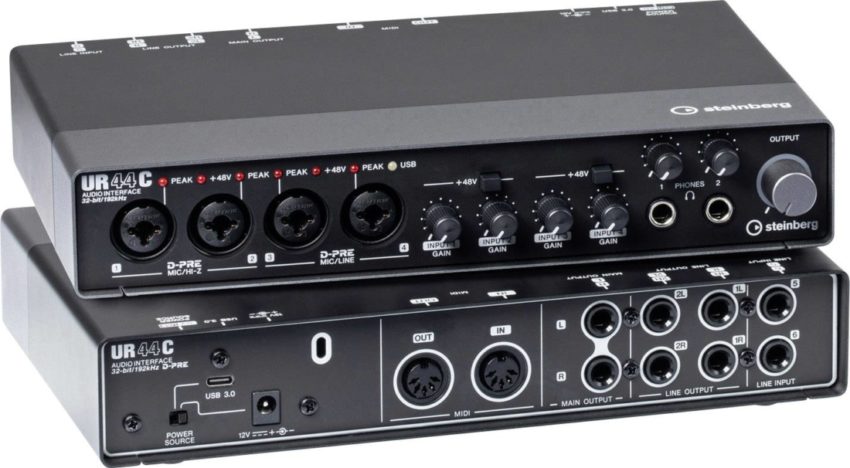
UR44C
This audio interface features a built-in DSP chip and runs onboard effects.

Studio 68c
Simple 4-channel audio interface with great-sounding preamps.
Best Audio Interfaces under $300
| Interface | Inputs | Outputs | MIDI I/O | Free Software | Connectivity |
|---|---|---|---|---|---|
| Audient iD14 | 2x XLR/TRS 1x D.I. | 2x TRS 1x Headphone | No | Yes | 1x USB |
| Audient Sono | 2x XLR/TRS 1x D.I. | 2x TRS 1x Headphone | No | Yes | 1x USB |
| PreSonus Studio 68c | 4x XLR/TRS | 2x TRS 1x Headphone | Yes | Yes | 1x USB |
| Steinberg UR44C | 4x XLR/TRS, 2 line-level | 2 x 1/4″ TRS (main out) 4 x 1/4″ (line out) 2 x 1/4″ headphones | Yes | Yes | 1x USB |
| Steinberg UR44 | 4x XLR/TRS 2x Line | 2x TRS Main 4x Line 1x Headphone | Yes | Yes | 1x USB |
| TASCAM US-4x4HR | 4X XLR/TRS | 4x TRS 2x Headphone | Yes | Yes | 1x USB-C |
| iConnectAUDIO4+ | 4x XLR/TRS | 4x TRS 1x Headphone | Yes | Yes | 2x USB |
| Behringer U-Phoria UMC404HD | 4x XLR/TRS 4x inserts (for effects) | 2x XLR 2x TRS RCA | Yes | Yes | 1x USB |
| SSL 2+ | 2x XLR/TRS | 2x TRS Main 2x Headphone RCA | Yes | Yes | 1x USB |
| Komplete Audio 6 mk2 | 2x XLR/TRS 2x Line | 4x TRS 2x Headphone | Yes | Yes | 1x USB |
| Scarlett 4i4 3rd Gen | 2x XLR/TRS 2x Line | 2x TRS 2x Headphone | Yes | Yes | 1x USB |
| Universal Audio Volt 276 | 2x XLR/TRS | 2x TRS 1x Headphone | Yes | Yes | 1x USB |
Let’s get straight into the list, starting with the Audio Interface that I actually use every day at home!
Audient iD14
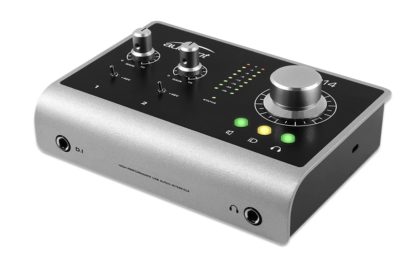
The Audient iD14, despite being an entry-level Audio Interface, comes with the ASP8024 Class-A Mic Preamp Circuit which is the same one used in the Audient consoles and it also has the Burr-Brown Converters.
The sound quality is absolutely fantastic, that is why it’s my top pick on this list.
Even though it only has 2 inputs, each with a mic/line input on combi XLR/jack sockets, it can be expanded through the optical input which allows for an extra 8 channels of ADAT at 44.1kHZ or 48kHz, 4 channels of ADAT at 88.2kHz or 96kHZ, or 2 channels of S/PDIF between 44.1kHz and 96kHz.
Channel one also has a ¼” instrument input.
Both channels have separate phantom power switches and they can increase the gain by up to 56dB.
The Audient iD14 can draw the power it needs to work through the USB port, but that won’t be enough to use phantom power though, you will need to plug in the DC adapter for this.
Taking a look at the outputs you can see that it only has one pair of line outputs which are on the back, and also a headphone jack in the front which is powerful enough to drive various sets of headphones such as the Sennheiser 650HD.
It comes with a great software control panel where you can show and hide different sections of the mixer and have a lot of control over what is going on!
I give the Audient iD14 the first spot on this list because even though it only has two channels, the sound quality is just too good for what you are paying.
Also, the price may seem a bit high for someone who is just starting out, but getting a cheaper one when you know that down the road you are going to want an upgrade, isn’t the best idea.
Plus, if two channels aren’t enough and you need more inputs you can expand by connecting an A-D and D-A converter such as the Audient ASP800 or maybe, if this one is too expensive, a cheaper option like the Behringer ADA8200, to the optical input on the back.
Find out more about the Audient iD14 here.
- Audient iD14: Amazon, Sweetwater.
Audient Sono

Here’s another addition by Audient, and this is one of my favorite Audio Interfaces for the simple fact that I’m also a Guitarist.
Not only does it work as a regular two-input audio interface that you can use to record microphones straight to your DAW, but it also features an instrument input with a built-in tube preamp including 12AX7 tube and 3-band EQ to shape your tone.
In addition to that, it comes with the Two Notes Torpedo Remote software, which essentially works as a Cabinet simulator, and you can save three of those to the Sono itself and it will work as an onboard DSP, which means that you can record without any latency whatsoever while still hearing to the processed audio, which isn’t possible with most other audio interfaces.
With most other audio interfaces, the audio signal gets processed by the computer, and this introduces latency, but since the Sono itself is doing all the work, you won’t have to deal with any latency ever, as long as you’re using the Two Notes software.
Not only that, but since you can save three different cabinet simulations onto the Sono, you can actually use it live by connecting straight into the mixer, which means that you won’t need to take an amp with you.
Having a built-in tube also lets you add some saturation and warmth to your guitar tones directly from the interface itself, which no other audio interface has ever been able to. Not only that, but you can route your channel-1 mic input to the tube as well to add some brightness to the vocals, for example.
In addition to all of this, you can expand the channel count to a total of 10 inputs via the ADAT optical input on the back by connecting something like the Audient ASP880, which means that you can transform this small 2-input interface into one capable of handling 10 inputs.
Lastly, the Sono lets you reamp your signal, which basically consists in taking a clean DI signal coming from the DAW, sending it over to your Amp, and then recording that amp into the session.
Is you can see, it’s an interface mainly designed for guitar players, but it works just like a regular interface and comes with Audient preamps, which sound phenomenal.
As far as price goes, it’s generally around $250, but I managed to get mine for $200 at the time, which I think is an absolute deal.
Find out more about the Audient Sono here.
- Audient Sono: Amazon, Sweetwater.
PreSonus Studio 68c

The Presonus Studio 68c comes with four XLR/TRS inputs that feature their XMAX preamps.
The recording quality can be up to 24-bit, 192kHz and the preamps sound great, very clean and crisp, with a lot of headroom.
You also get S/PIDIF I/O, along with MIDI I/O for your keyboard controller, which makes it a very versatile interface.
On the back, you will find the headphone output, which should be on the front in my opinion, 2x TRS main outputs, and 2x Line outputs.
As far as the free software that comes included with the PreSonus Studio 68c, you get the Studio One Artist DAW, and the Studio Magic Plug-in Suite, all available in AAX, VST, and AU formats, and they’re compatible with any DAW you choose.
If you’re just starting out but you need a high-quality interface that won’t need to be upgraded anytime soon, then the PreSonus Studio 68c will be a great investment!
Find out more about the Presonus Studio 68c here.
- PreSonus Studio 68c: Amazon, Sweetwater.
If you think that a Mixer may better suit your needs than an Audio Interface, read this post I wrote about 7 affordable mixers that have USB Multi-Track recording.
Steinberg UR44C

Steinberg’s UR44C USB interface was designed with traveling music makers in mind. Renowned Yamaha coherence is offered up in a rugged and road-worthy portable enclosure.
The UR44C features 4 Yamaha D-PRE mic/line level preamps on the front panel, 2 of which may be switched to HI-Z instrument inputs, along with 2 additional line-level inputs on the back panel. 6 analog outputs, 2 independently adjustable headphone outputs, and MIDI I/O compatibility are all made available.
The UR44C uses a Yamaha SSP3 chip for its DSP, with their dspMixFx app offering control over it. A channel strip with EQ and compression, REV-X hall/plate/room reverb, plus clean, crunch, drive, and lead guitar amplifier emulations are included.
All these effects, bar one, can be used for either tracking or exclusively monitoring. Its reverb effect can only be used for monitoring, you will have to use the plugin version of the effect in your DAW if you would like it to be included in your recording.
Find out more about the Steinberg’s UR44C here:
- Steinberg’s UR44C: Amazon, Sweetwater.
Steinberg UR44
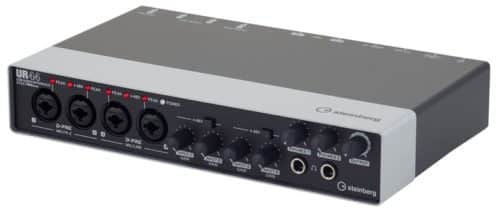
The Steinberg UR44 is a 6-in and 4-out Audio Interface and it comes with the D-Pre-Preamps and it offers latency-free monitoring with some effects.
The build quality is really outstanding and it’s actually pretty heavy!
This interface, even though it connects to the PC via USB, cannot be powered by it, you need to connect the 12v DC adaptor.
It can also be used with an iPad, all you have to do is use an iPad camera connection kit which will allow you to connect from the USB cable from the Interface to the iPad.
When taking a look at the inputs on the front, we have four combi XLR/jack sockets. The first two are set at Instrument level while the last two are line level.
Phantom Power can be supplied to the 4 inputs via two switches, the first one will feed Phantom Power to the first two inputs and the second one will feed the third and fourth ones.
On the front, you can also see multi-colored LEDs that show input activity as well as overload/clipping on every channel.
This interface doesn’t have a PAD switch but you can activate a High-Pass filter and phase flip/polarity flip through the software control.
There are two more inputs on the back. You can switch their sensitivity from +4dBu or -10dBu, which comes in handy.
There are also four Line outputs on the back, and two additional main left and right line outputs that carry the same signals as outputs 1–2. This is useful for users wanting to connect a second set of monitors.
When you buy it you get thr Yamaha DSP bundle, which comprises of the REV-X reverb, the Sweet Spot Morphing Channel Strip Comp/EQ, and the amp simulator “Guitar Amps Classics”.
Lastly, you also get Cubase AI, but not the full version.
The Steinberg UR44 is also a good option, you get a lot of Inputs and outputs and you can use it with an iPad.
You might also be interested in reading about the Best USB Microphones available. Here’s the post I wrote on that topic.
Find out more about the Steinberg UR44 here.
- Steinberg UR44: Amazon, Sweetwater.
TASCAM US-4x4HR
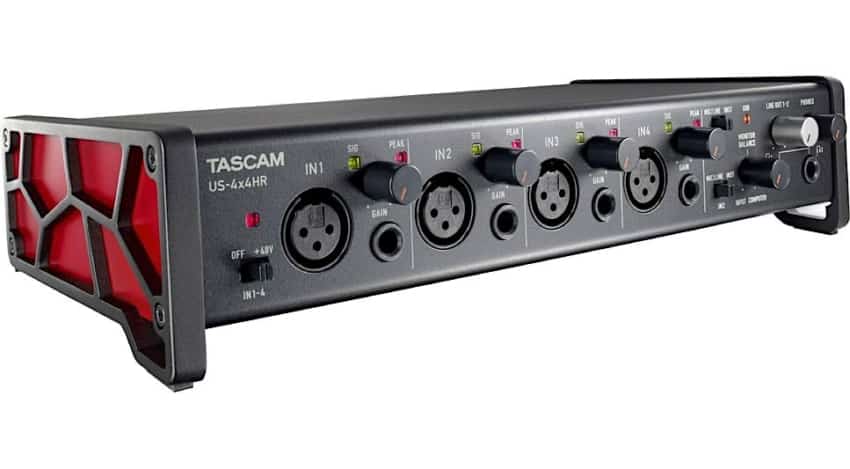
The TASCAM US-4x4HR audio interface can record up to 192kHz audio, it connects to your PC/Mac via USB-C, and features dependable 5-pin MIDI in/out, and super-low-latency tracking and monitoring.
It comes with 4 Ultra-HDDA mic preamps that can give you up to 57dB of clean gain to capably drive most dynamic mics, even ones that require huge amounts of gain, such as the Shure SM7B, and onboard +48V phantom power to support your condensers.
Each channel has a TRS input, a gain knob, and signal and peak LED indicators. Additionally, Channels 1 and 2 give you impedance switches for direct input of guitars, bass, and other instruments.
Having MIDI ins and outs means that you can connect your MIDI keyboards & controllers directly to the interface, which is always a plus.
The Tascam US-4x4HR can be 100% powered via the USB connection, which means that you won’t need to deal with additional cables.
Lastly, it allows for zero-latency monitoring, and it comes with not just one, but two headphone outputs!
Find out more about the TASCAM US-4x4HR here.
- TASCAM US-4x4HR: Amazon, Sweetwater.
iConnectAUDIO4+

The first thing that stands out from this Interface is that it can be connected to a PC and a Mac simultaneously, or to a PC/Mac and an iPad.
This means that you can record into a DAW on your PC but use the iPad for effects simultaneously without any issues.
It has 4 combi XLR/ ¼” TRS inputs on the front. Inputs one and two are Mic and Instrument level, while three and four are Mic and Line Level.
A huge difference between this interface and the rest is that it only has one knob, the rest is controlled via the touch screen on the front. You can choose which input to activate, then set the level for that input.
This interface provides 48v Phantom Power which can be turned on via the touch screen.
The four outputs are on the back and the cool thing about them is that you can do with them what you want, if you want to send out a mono mix through one you can do that through the software that comes with the Interface.
You can send a DI through another output for re-amping, and so on!
In general, most interfaces only have monitor outputs. This makes this interface a lot more versatile.
The preamps are very clean sounding, and it can record at 24-bit/192kHz.
When buying this Interface, you get Ableton Live Lite and also some free samples and loops by Big Fish Audio.
The iConnectAUDIO4+ is a damn good investment just for its huge versatility alone, but it also sounds amazing!
Find out more about the iConnectAUDIO4+ here.
Behringer U-Phoria UMC404HD
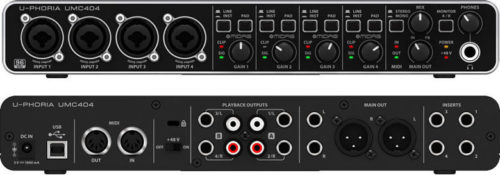
The Behringer UMC404HD is by far the cheapest on this list and logically it’s not the best, but for what you are actually spending, you are getting a great product!
This Audio Interface uses the MIDAS preamps on their front 4x XLR/TRS combo inputs. These preamps are actually pretty good and the sound you get from this Interface is pretty damn impressive.
The highest recording quality you can achieve is 24-bit / 192kHz.
The Behringer U-Phoria UMC4040HD mix control gives you zero-latency input monitoring, letting you experience your performance with no delay or lag in the returning signal.
On the Front, you have the four inputs, a gain knob for every input channel with a PAD and a Line/Instrument level selector. You also get a Headphone output.
Also, with just the press of a button, you can playback in mono or in stereo… Checking your mixes in mono is very important if you want them to really sound the way they are supposed to.
If you’re interested in reading more about mixing in mono you can read this entire article I wrote about it!
This Audio Interface also supplies v48 Phantom power, which can be turned on or off by pressing a single switch (it’s one switch for all channels, it would be a lot better to have individual control for each one).
On the back, you can see the MIDI I/O, Phantom Power control, the analog outputs, and the 4 inserts. The inserts can be used to add effects to the chain such as Gate, EQ, Compressors, etc.
This one is a great value, it does what it’s supposed to… but you probably won’t get the same sound quality as with any of the aforementioned interfaces.
That being said, if you aren’t used to recording then the Behringer U-Phoria UMC404HD is a great first buy. A beginner won’t really be able to tell the difference in sound quality between this and a much more expensive one.
Still, if you know that down the road you are going to be upgrading, just buy one that’s slightly more expensive and better.
Find out more about the Behringer U-Phoria UMC404HD here.
- Behringer U-Phoria UMC404HD: Amazon, Sweetwater.
SSL 2+
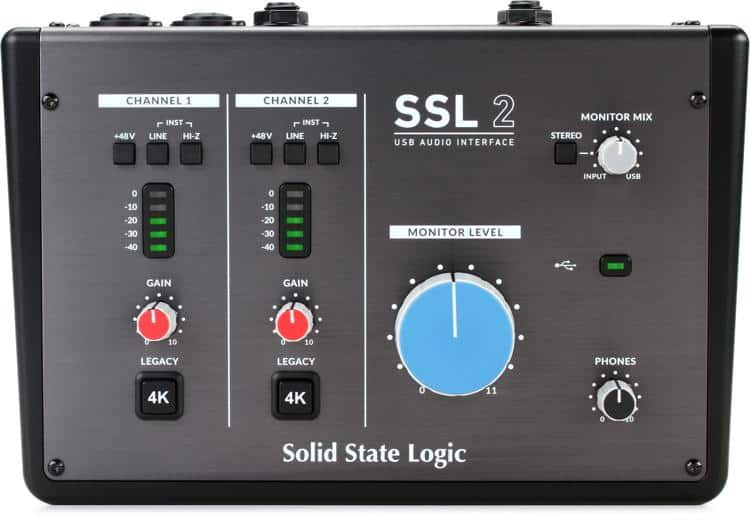
Solid State Logic has been in the recording & mixing industry for over forty years now, and they are mostly known for their high-end mixing consoled used by many top producers.
The SSL 2+ features two XLR-1/4″ analog inputs with superior quality preamps and converters for mic, instrument, and line-level signals, as well as two 1/4″ TRS main outputs, and two headphone outputs, and RCA Stereo out.
In addition to this, MIDI I/O is also available on the SSL 2+.
One feature that differentiates this audio interface from all the other ones on this list, is the “4K” button.
This button emulates the sonic characteristics of the SSL 4000 series consoles with the press of a button, boosting the high-end and adding a bit of harmonic distortion.
Lastly, it also comes with a included software bundle from Avid, Ableton, and Native Instruments, and over 1.5GBs of samples from Loopcloud, as well as multiple audio processing plugins.
The SSL 2+ and the Audient iD14 are my top two recommendations as far as quality goes.
Get the SSL 2+ here:
- SSL 2+: Amazon, Sweetwater.
N.I. Komplete Audio 6 Mk2
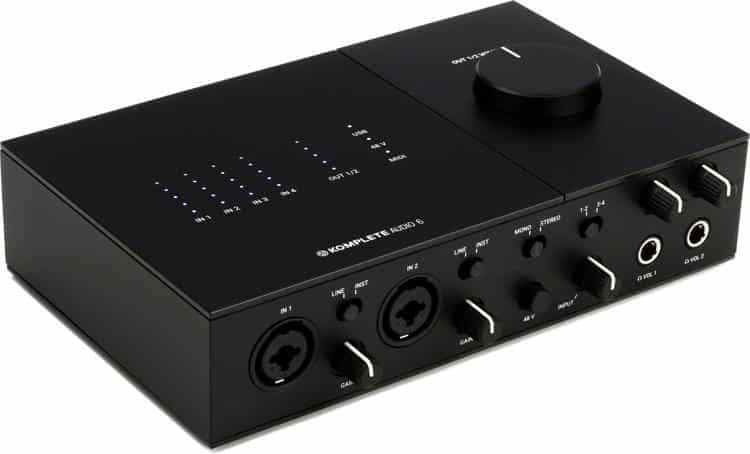
The Komplete Audio 6 mk2 is made by Native Instruments, one of the biggest names in the music-related software space.
It features two XLR/TRS combo mic, line and instrument level inputs as well as two TRS line inputs, four TRS outputs, two headphone outputs, MIDI I/O, and S/PDIF.
What makes this Audio Interface stand out isn’t necessarily the interface itself, but rather the huge amount of software that comes included, since it comes with several GB of included virtual instruments, effects, Ableton Live 10 Lite and Traktor LE 3 software, and even a $25 voucher to buy more software on their site.
If you’re an aspiring music producer that needs an Audio Interface as well as many different virtual instruments and effects, as well as a free DAW, this one might be for you.
Find out more about the Komplete Audio 6 mk2 here.
- Komplete Audio 6 mk2: Amazon, Sweetwater.
Focusrite Scarlett 4i4 3rd gen

The Scarlett 4i4 3rd Gen has two XLR/TRS mic, line and instrument level inputs on the front and two extra line inputs on the back, and it provides four Line outputs on the back as well as a headphone output on the front, plus MIDI I/O.
The 3rd generation of the Scarlett audio interfaces introduced the “Air” circuit, which is designed to make the higher end sound more open or “Airy”, making it easier to achieve a better high-end.
In terms of sound quality, like all Focusrite Audio Interfaces, it sounds fantastic, plus it’s very easy to set up and use!
As far as the included software goes, you get a copy of Ableton Live Lite, Focusrite Red Plug-in Suite, Pro Tools First Creative Pack, and Softube’s Time and Tone Bundle.
Learn more about the Scarlett 4i4 3rd Gen here.
- Focusrite Scarlett 4i4 3rd gen: Amazon, Sweetwater.
Universal Audio Volt 276

The UA Volt 276 is an amazing small-format and compact audio interface that’s capable of recording audio at a whopping 24 bits/192 kHz.
It’s got 2 XLR/TRS combo jacks on the front with two corresponding switches that let you select between Mic, Line-level, and instrument-level inputs, a +48v phantom power switch, MIDI I/O on the back, as well as two TRS monitor outs and a headphone output.
What really stands out about this interface is the way it looks since it’s got two pieces of wood on the sides instead of metal panels, which gives it a nice organic look.
While it may seem like your standard 2-input audio interface, the Volt 276 features a built-in 76 compressor for both inputs, which is based on the UA1167 compressor, with three different types of compressions, one for vocals, Guitar, and “Fast”, and you can switch between them by pressing on the “76 Compressor” button.
It’s worth noting that this is not just a compressor, but also a limiter.
In addition to this, it features a “Vintage” mode which essentially works just like the Focusrite Air Circuit and the SSL “4K” switch, which brightens up the sound by boosting the higher frequencies.
The “Monitor” button gives you direct monitoring capabilities and it also allows you to switch between stereo and mono if you press it again.
Lastly, when purchasing this interface, you also get a free copy of Ableton Live Lite, Softube Marshall Plexi Classic Amp Softube Time & Tone Bundle, Celemony Melodyne Essential, Relab LX480 Essentials, UJAM Virtual Drummer DEEP and Virtual Bassist DANDY, and a couple more free plugins.
Learn more about the Universal Audio Volt 276 here.
- Universal Audio Volt 276: Amazon, Sweetwater.
Top 3 recommendations
In terms of sound quality, I would either recommend the Audient iD14 or the SSL 2+ since these have the best preamps and converters.
However, if you’re on a tight budget, then go with the Behringer UMC404HD, since it’s the one that offers the best overall value.
Conclusion
Buying an Audio Interface is no simple process mainly because there are way too many out there.
Every single one on this list is definitely worth the money, especially the Audient iD14 and the SSL 2+.
If I had to choose, I would definitely get the Audient iD14 simply for its sound quality and because you can increase the channel count through the optical port.
If you think that an Audio Interface may not be exactly what you need, you could also take a look at this entire post I wrote about 7 affordable mixers that have USB Multi-Track recording.
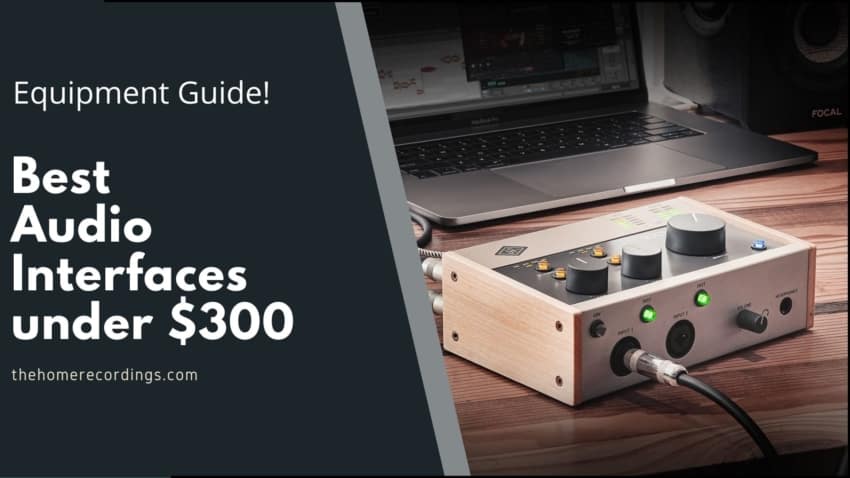
Today I was working with GarageBand and a legacy M-Audio Fast Track interface. I was able to set up two tracks, one for Mic, one for Guitar. But GarageBand would only record whichever track was selected — I couldn’t record two tracks simultaneously. Is this a limitation of the Fast Track, GarageBand, or my Mac? (Late 2013 iMac, running 10.14.6). I’d hate to purchase a new interface and discover that I could only record one track at a time.